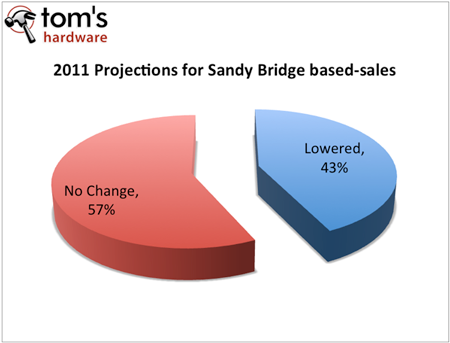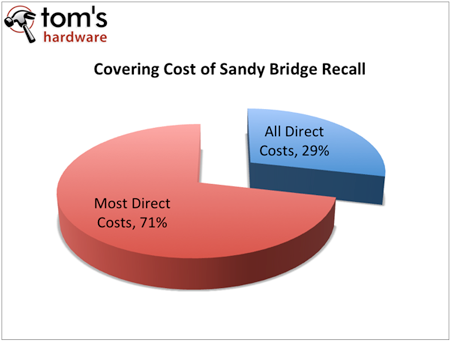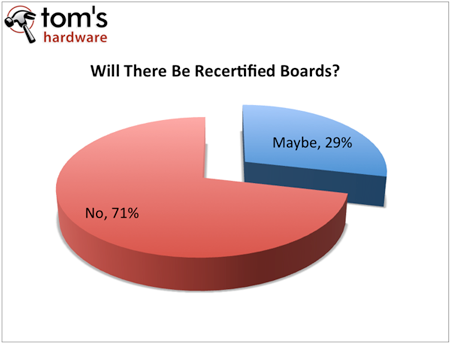Behind the Tech: Sandy Bridge Recall, An Insider's Story
The Fallout
Most of our survey participants have not lowered their projected Sandy Bridge-based sales (P67/H67 motherboards) for 2011. The sales for Q1 are no doubt lower, but most companies we talked to feel that they can make up the numbers in Q2, Q3, and Q4. Putting this in perspective, Asus lost about $34 million in revenue for the month of February. However, we are told this number is not just due to motherboards. Building a PC involves many more components, which is why the recall had an unforeseen ripple effect on the entire PC supply chain. Customers holding off on buying a P67-based motherboard are also holding off on new memory, graphic cards, and storage.
As consumers, this is great news. Starting in April and May, there are going to be many excellent deals, because every sales team will be under pressure to hit those sales quotas. Most of our motherboard contacts do feel that Z68 is going to put a little bit of pressure on P67 because of some demographic overlap. But, for the most part, no one expects P67 to suffer from Z68's introduction. At the same time, Z68 is going to be very price-competitive, since every company will be scrambling to recover revenue lost in Q1.
According to our motherboard contacts, Intel is not covering all of the expenses related to its stop-shipment action. The company is reimbursing the direct production and distribution costs. Naturally, opportunity costs such as the lost sales revenue are not going to be covered, although negotiations continue as companies try to recover related recall costs.
For example, Asus is taking the initiative in its own recall by covering the cost of shipping motherboards between the company and end-users. As one company stated, “We want to serve our customers first. We will deal with the costs later.”
According to customer protection laws, any motherboard that a customer returns to have its chipset replaced must be sold as “recertified” or “refurbished.” Because Intel is reimbursing companies on a per-unit basis, the terms of many reimbursement contracts require motherboard companies to send the board back to Intel. We are told that some companies are considering merely replacing the chipsets on used boards, but this is unlikely. If Intel is willing to cover the cost of replacing the entire board, it is doubtful that any motherboard company would choose to replace only the chipset, which would result in lower quality. Resoldering a chipset adds a level of complexity that lowers the production yield compared to factory new motherboards, because some will fail the re-validation process.
Either way, these motherboards will be labeled if they are sold. However, if a B2 motherboard was in the factory waiting to be shipped prior to the stop-shipment, replacing a chipset and labeling the motherboard as “new” is still perfectly legal.
After this experience, every company with which we spoke is more willing to question an anomaly in the design stage. Intel admitted that its partners discovered the chipset problem. This is odd when you consider that Intel’s validation process involves more than 3000 engineers globally. They take new silicon through a grueling testing process for several months and into environments that the typical user will never see.
Get Tom's Hardware's best news and in-depth reviews, straight to your inbox.
-
acku Reply9512301 said:Lol, that neighborhood watch picture still creeps me out to this day.
Well that's why you shouldn't talk to strangers. :) -
dogman_1234 So Intel noticed the problem before hand and did nothing until it became apparent? I am not one to criticize Intel, but if any error is noticed, i would warn of it immediately.Reply -
ferelden Sandybridge performance is just too beastly for this to affect it long term, most people who have just come into the cpu market to upgrade didn't even realize there was a recall in the past and just got a b3 p67 and i5-2500k without any hesitationReply -
Stardude82 Knowing the problem, I'd totally buy a B2 board at a serious discount. Most PC's only have 2 drives anyway and SATA add-on cards are cheap.Reply -
f-14 i didn't see any problem for sales, people just bought core i-7 9XX'sReply
AMD could crow all they wanted, they didn't have a new product going to the shelf capable of beating the previous i-series. now had AMD released llano during this, they would have made a pre-emeptive death knell strike against sandybridge, but they didn't so it didn't matter what happened until AMD does. -
f-14 oh and also the problem could have been more easily rectified by intel giving out coupons for sata3 devices priced to match sata2 devices and pull it off as a promo that would have sold them millions more in profits.Reply
as for the people who already bought a 'free' sata 2 device to sata3 replacement device coupon would have been cheaper also.
Intel just blew a huge marketing opprotunity to grind AMD under the imperial capitalist yankee boot.
IMO -
joytech22 All I can say after reading this is that Intel did a great job with this issue.Reply
But it somehow still brings me back to how AMD is still spending money on a product we haven't even seen benchmarks about yet.
Somebody who uses an OEM machine somewhere around the world MUST have released a benchmark of Llano or BD at some point in time. -
rolli59 It is just business! I wonder if the speculations on the time line is true but most definitely the OEM's had discovered problems well before release.Reply -
emergancy exit or people are just brand loyal to the point of insanity. and intel is cashing in and and keeping their prices high.Reply


